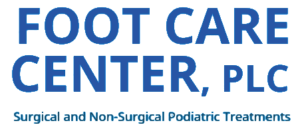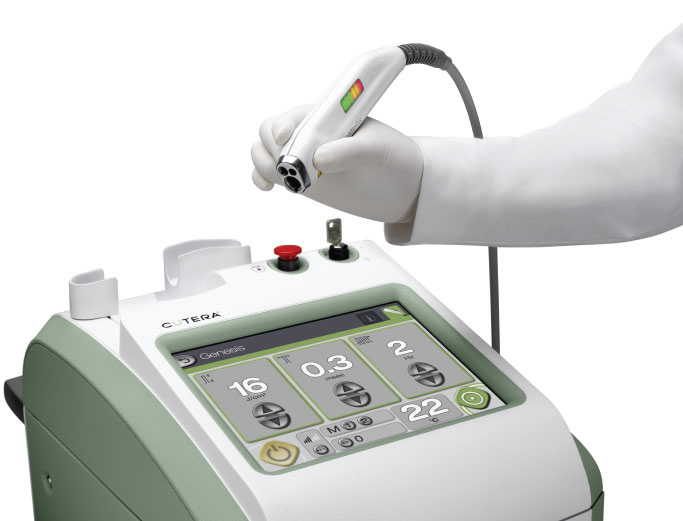Do you have discolored thick toenails?
The most powerful Nd:YAG laser for toenail fungus and skin rejuvenation. GenesisPlus is the culmination of more than a decade of experience and one of Cutera’s most advanced Nd:YAG laser systems.
A specially designed laser beams through the toenail and safely kills the organisms embedded in the nail bed that cause Onychomycosis – more commonly known as toenail fungus.
The procedure requires one or a small number of safe, quick treatments with little or no discomfort and is performed as an outpatient service with no anesthesia. The gentle laser light beam has no effect on healthy tissue and treats only the infected area of the toe. No drugs or topical ointments are used, eliminating the total-body side effects of traditional oral medications.
Clinical studies show that the laser kills toenail fungus and promotes clear nail growth with a single treatment in better than 80% of cases. The laser treatment is safe, effective, and most patients improve usually after their first treatment.
What is GenesisPlus?
GenesisPlus is a Nd:YAG 1064nm laser that has been cleared by the FDA to be both a safe and effective solution for the treatment of nail infection (onychomycosis), more commonly known as toenail fungus. This laser is also a safe and effective treatment for scar reduction and warts.
About Toenail Fungus
What causes nail infection? (onychomycosis)
Dermatophytes are the fungi most commonly responsible for causing this condition. They are specialized organisms that live off of keratin which is the main component of nails and skin. The most common fungi that cause nail infection disease are Trichophyton rubrum, Trichophyton mentagrophytes, and Candida albicans. Everyone is at risk for infection because fungus is present everywhere in the environment.
Where does nail infection come from?
Nail infection is caused by contact with dermatophytes which are everywhere in our environment. Common sources of infection include swimming pools, public showers, gyms and nail spas. Tight fitting shoes and nail trauma can also lead to infection. Genetic susceptibility, poor health and increasing age are also factors that increase the risk of nail infection.
What are the symptoms of nail infection?
You may suffer from nail infection (onychomycosis) if you have one or more of the following symptoms:
Discolored nails
Yellow streaks under the nail
Distorted or thickened nails
Brittle, crumbly or ragged nail
Nails separated from the underlying skin
Buildup of debris (nail fragments, skin) under the nail
White spots or streaks on the nail surface
Signs & Symptoms
The first sign of nail fungus is a slight change in the nail color often at the tip or corner of the nail but patches may begin anywhere under the nail even close to the cuticle. The color may be white, yellow or brown or darker and appear in patches or even streaks in the nail. The nail may become brittle and crumble or seem to chip easily. As the infection progresses nails can change shape and become thick causing a buildup of keratin and fungal debris under the nail. In some cases an odor may be present. The nail will begin to lose its luster and shine. The nail may crack or become raised from the nail bed making it difficult to wear shoes and socks comfortably. The affected nail(s) may start to grow inward causing painful ingrown nails. This may raise your risk for secondary skin or toe infections.
Why is it important to treat?
Ignoring the infection may allow it to spread to other toenails, skin on the feet and even fingernails. The nail may become permanently deformed, cause abscesses under the nail and put you at risk for other serious fungal and bacterial infections. In diabetics or other immune compromised patients it may delay healing or cause or worsen foot ulcers.
Frequently Asked Questions
What is GenesisPlus?
GenesisPlus is a new laser perfected for safely and effectively treating onychomycosis (toenail fungus). By targeting the fungus directly, GenesisPlus gets to the source of the problem immediately.
How does GenesisPlus work?
Tiny pulses of light from the GenesisPlus laser pass through the toenail to the fungus underneath. The fungus is irradiated without any damage to the surrounding nail or skin.
How long does the procedure take?
Depending on how many toes are affected, the GenesisPlus laser procedure will take 10-20 minutes.
Is GenesisPlus painful?
Most people feel a slight warming sensation during the the procedure. No pain medication is needed and most people find the treatment very easy to tolerate.
How many treatments will I need?
Consult your provider. Many patients only need one treatment, but some need more if they have severe cases of toenail fungus.
Are there any restrictions on my activity post procedure?
You can resume your normal activities immediately.
When will I see results?
You won’t notice anything immediately following treatment. However, as your nail grows out, the new nail growth should be clear. Toe nails grow slowly – especially nails infected with fungus. So, it may take 6-12 months for your toenail to clear.
Will the fungus come back?
Reinfection with toenail fungus may be acquired anywhere from your environment, for example, in damp areas such as public swimming pools. Consult with your healthcare professional to understand how to prevent toenail fungus from reoccurring.
When can I apply nail polish?
While it is important to remove nail polish, decoration and jewelry prior to treatment, you can reapply nail polish 24 hours after treatment.
How does GenesisPlus compare to other toenail fungus treatments?
Traditional treatments such as nail trimming, topical medicine, oral medicine or nail removal have significant drawbacks. Nail trimming doesn’t treat the fungus. Topical medicines need to be applied for 12 months and have a low success rate. Oral medicines are taken for 3 months but can cause liver or kidney problems. GenesisPlus is a quick, easy, safe, effective procedure that treats the fungus at the source.


